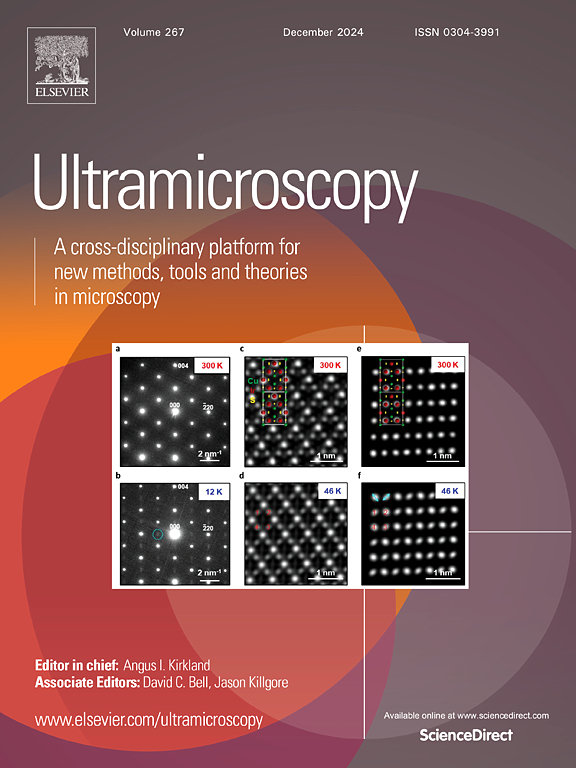电子束传播对1纳米宽GaN/AlGaN量子阱高分辨率定量化学分析的影响
IF 2
3区 工程技术
Q2 MICROSCOPY
引用次数: 0
摘要
扫描透射电子显微镜(STEM)中高分辨率光谱分析的最新进展为在原子尺度上测量晶体材料中化学物质的浓度铺平了道路。然而,一些人为因素使实验数据的直接解释复杂化。例如,在能量色散x射线(EDX)光谱学中,电子束传播过程中的通道效应和串扰破坏了局部x射线发射对成分的线性依赖。为了解决这些挑战,有必要采用一种将实验数据与非弹性散射模拟相结合的方法。该方法旨在解释电子束传播对x射线发射的影响,本质上是确定收集信号的数量和空间来源。在这篇文章中,我们建议在涉及聚焦离子束(FIB)制备的III-N多层器件的实际案例研究中评估该方法的精度和灵敏度限制。该器件具有名义上纯的~ 1.5 nm宽的GaN量子阱,被含有低浓度铝(~ 5 at%)的AlGaN势垒包围。通过采用原子尺度的EDX采集,基于超过几千帧的平均,校准ζ因子结合多层x射线吸收校正模型进行量化,并通过比较从量子阱获得的x射线辐射与参考10纳米宽结构,我们证明了光束传播对化学成分的定量影响可以精确地解释。导致在原子尺度上的成分灵敏度低至±0.25 at%。最后,讨论了实现这种高精度水平的实际方面,特别是在非弹性多片模拟,不确定性确定和样品质量方面。本文章由计算机程序翻译,如有差异,请以英文原文为准。
Impact of electron beam propagation on high-resolution quantitative chemical analysis of 1-nm-wide GaN/AlGaN quantum wells
Recent advancements in high-resolution spectroscopy analyses within the scanning transmission electron microscope (STEM) have paved the way for measuring the concentration of chemical species in crystalline materials at the atomic scale. However, several artifacts complicate the direct interpretation of experimental data. For instance, in the case of energy-dispersive X-ray (EDX) spectroscopy, the linear dependency of local X-ray emission on composition is disrupted by channeling effects and cross-talk during electron beam propagation. To address these challenges, it becomes necessary to adopt an approach that combines experimental data with inelastic scattering simulations. This method aims to account for the effects of electron beam propagation on X-ray emission, essentially determining the quantity and the spatial origin of the collected signal. In this publication, we propose to assess the precision and sensitivity limits of this approach in a practical case study involving a focused ion beam (FIB)-prepared III-N multilayers device. The device features nominally pure ∼1.5-nm-wide GaN quantum wells surrounded by AlGaN barriers containing a low concentration of aluminum (∼5 at%). By employing atomic-scale EDX acquisitions based on the averaging of more than several thousand frames, calibrated factors combined with a multilayer X-ray absorption correction model for quantification, and by comparing the X-ray radiation obtained from the quantum well with a reference 10-nm-wide structure, we demonstrate that the quantitative impact of beam propagation on chemical composition can be precisely accounted for, resulting in a composition sensitivity at the atomic scale as low as 0.25 at%. Finally, practical aspects to achieve this high precision level are discussed, particularly in terms of inelastic multislice simulation, uncertainty determination, and sample quality.
求助全文
通过发布文献求助,成功后即可免费获取论文全文。
去求助
来源期刊

Ultramicroscopy
工程技术-显微镜技术
CiteScore
4.60
自引率
13.60%
发文量
117
审稿时长
5.3 months
期刊介绍:
Ultramicroscopy is an established journal that provides a forum for the publication of original research papers, invited reviews and rapid communications. The scope of Ultramicroscopy is to describe advances in instrumentation, methods and theory related to all modes of microscopical imaging, diffraction and spectroscopy in the life and physical sciences.
 求助内容:
求助内容: 应助结果提醒方式:
应助结果提醒方式:


